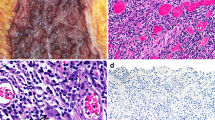Abstract
The modified Steiner stain is a non-specific silver stain for identifying bacteria in formalin-fixed, paraffin-embedded tissues. The principle behind its use is that bacteria are first sensitized using uranyl nitrate solution, making them able to precipitate silver from a silver nitrate solution. It is used routinely for staining gastric biopsies to identify Helicobacter pylori. Upon staining a gastric biopsy from a patient with acquired immunodeficiency syndrome (AIDS) and cytomegalovirus gastritis, we recognized that this technique also stains the viral inclusions of cytomegalovirus-infected cells. We then proceeded to stain 43 consecutive cytomegalovirus-positive gastrointestinal biopsies from 33 immunocompromised patients based on positive cytomegalovirus immunohistochemistry (DAKO-cytomegalovirus monoclonal antibody, clones DDG9 and CCH2). We also stained eight cytomegalovirus-infected, non-gastrointestinal tissue s, including lung, adrenal gland, ovary, skin and neural tissue, to ensure that the stain was staining the cytomegalovirus-infected cells and not argyrophilic or argentaffin neuroendocrine cells of the gastrointestinal tract. In 40 of the 43 cytomegalovirus-infected gastrointestinal biopsies, we saw positive staining with the modified Steiner stain (93% sensitivity). The cytomegalovirus-infected, non-gastrointestinal tissues all stained positively with the modified Steiner stain. Because the modified Steiner stain is frequently used to identify Helicobacter pylori in gastric biopsies, we propose that it be studied further for possible use either as a screen or as a confirmatory tool, or both, for cytomegalovirus inclusions in gastrointestinal biopsies.
Similar content being viewed by others
References
Dietrich, D.T. & Rahmin, M. (1991) Cytomegalovirus colitis in AIDS: presentation in 44 patients and a review of the literature. J. AIDS 4, S29-S35.
Francis, N.D., Boylston, A.W., Roberts, A.H.G., Parkin, J.M. & Pinching, A.J. (1989) Cytomegalovirus infection in gastrointestinal tracts of patients infected with HIV-1 or AIDS. J. Clin. Pathol. 42, 1055-64.
Hsu, S.M., Raine, L. & Fanger, H. (1981) Use of avidin- biotin peroxidase complex (ABC) in immunoperoxidase techniques: a comparison between ABC and unlabeled antibody (PAP) procedures. J. Histochem. Cytochem. 29, 577-80.
Luna, L.G. (ed.) (1968) Manual of Histologic Staining Methods of the Armed Forces Institute of Pathology, 3rd edn. New York: McGraw-Hill.
Martin, A.M., Jr & Kurtz, S.M. (1966) Cytomegalic inclusion disease: an electron microscopic histochemical study of the virus at necropsy. Arch. Pathol. 82, 27-34.
Nador, R.G., Cesarman, E., Chadburn, A., Dawson, D.B., Ansari, M.Q., Said, J. & Knowles, D.M. (1996) Primary effusion lymphoma: a distinct clinicopathologic entity associated with the Kaposi's sarcoma-associated herpes virus. Blood 88, 645-56.
Platcher, B., Nordin, M., Zweygberg Wirgart, B., Mach, M., Stein, H., Grillner, L. et al. (1992) The DNA-binding protein P52 of human cytomegalovirus reacts with monoclonal antibody CCH2 and associates with the nuclear membrane at late times after infection. Virus Res. 24, 265-76.
Rights and permissions
About this article
Cite this article
Saiz, E., Lubin, J. & Robinson, M.J. The Modified Steiner Stain: a New Use for an Old Stain? Staining Cytomegalovirus-infected Cells in Gastrointestinal Biopsies. Histochem J 30, 549–552 (1998). https://doi.org/10.1023/A:1003287218401
Issue Date:
DOI: https://doi.org/10.1023/A:1003287218401




